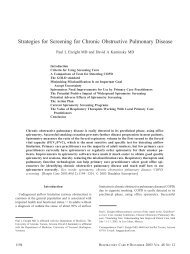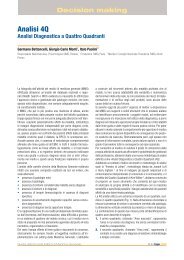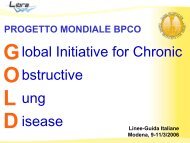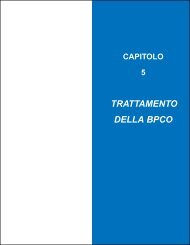COPD phenotypes - GOLD
COPD phenotypes - GOLD
COPD phenotypes - GOLD
Create successful ePaper yourself
Turn your PDF publications into a flip-book with our unique Google optimized e-Paper software.
600 AMERICAN JOURNAL OF RESPIRATORY AND CRITICAL CARE MEDICINE VOL 182 2010<br />
FEV 1 , however, may indicate a distinct phenotype. Rapid<br />
decline in FEV 1 is not only predictive of morbidity, mortality,<br />
and hospitalization rates (12) but has also been linked to distinct<br />
plasma biomarker signatures (13). Bronchodilator reversibility<br />
and airway hyperresponsiveness are highly variable in patients<br />
with <strong>COPD</strong> from patient to patient, and also within a given<br />
patient when measured serially over time, and thus have limited<br />
sensitivity or specificity in distinguishing <strong>COPD</strong> from asthma<br />
(14, 15). Airway hyperresponsiveness has been associated with<br />
a greater longitudinal decline in lung function; bronchodilator<br />
reversibility defined as change in FEV 1 may be less common<br />
with an emphysema-dominant phenotype (14, 16). Hyperinflation<br />
may also define patient groups associated with varying<br />
mortality or functional impairment (17, 18). Similarly, diffusing<br />
capacity impairment is an independent predictor of the magnitude<br />
of radiologic emphysema (19), presence of resting hypoxemia,<br />
exercise-induced arterial oxygen desaturation (20), and<br />
functional impairment (21). Although we cannot say with<br />
certainty, this may reflect unique biologic processes (22). Other<br />
physiologic measures, such as hypercapnia, physiologic exercise<br />
impairment, or even measures of physical activity derived from<br />
actigraphy, may also reflect unique biological processes and<br />
consequently potential opportunities for unique therapeutic<br />
interventions (23, 24).<br />
Radiologic Characterization<br />
Quantitative assessment of emphysema by computed tomography<br />
(CT) scanning offers an objective measure of parenchymal<br />
disease that correlates well with histopathologic findings and is<br />
predictive of the degree of expiratory airflow obstruction (25).<br />
Objective measures of proximal airway wall thickening<br />
obtained via CT are inversely correlated with lung function<br />
and relate to a subject’s burden of small airway disease (26) and<br />
exacerbation frequency (27). More recent work suggests that<br />
the correlative strength between CT measures of airway wall<br />
thickening and lung function increase when examining more<br />
distal fourth- and fifth-generation airways (28), although such<br />
structures approach the limits of accurate measurement using<br />
most currently available CT imaging reconstruction protocols<br />
and should therefore be used with caution.<br />
Whether or not the presence of specific lung structural<br />
abnormalities (including emphysema, airway wall thickening,<br />
and/or bronchiectasis) predict meaningful clinical outcome is<br />
an area of current research interest (29, 30). Increasing<br />
emphysema severity as defined by CT has been associated<br />
with worse health status (27) and increased mortality (31). The<br />
National Emphysema Treatment Trial provides the most<br />
compelling evidence supporting distinct CT-based <strong>phenotypes</strong><br />
in defining an increased risk of mortality in patients with<br />
homogenous emphysema and impaired FEV 1 or diffusing<br />
capacity of carbon monoxide undergoing LVRS, whereas<br />
upper lobe–predominant emphysema and a low postrehabilitation<br />
exercise capacity identify a group of emphysema<br />
patients who experience a mortality and functional benefit<br />
from LVRS (16). These compelling data strongly support that<br />
a combination of CT imaging and physiological testing can<br />
clearly impact therapeutic decision making, thus validating its<br />
value as a phenotype according to our operational definition.<br />
<strong>COPD</strong> Exacerbations<br />
Within the framework we have proposed, an acute exacerbation<br />
of <strong>COPD</strong> (AE<strong>COPD</strong>) could be viewed as outcome or, in the<br />
context of describing a ‘‘frequent exacerbator,’’ a phenotype.<br />
AE<strong>COPD</strong> is currently defined as: ‘‘A sustained worsening of<br />
the patient’s condition, from the stable state and beyond normal<br />
day-to-day variations, that is acute in onset and necessitates<br />
a change in regular medication in a patient with underlying<br />
<strong>COPD</strong>’’ (32). This general description poses numerous operational<br />
challenges for use in clinical phenotyping. It remains<br />
unclear if these changes are quantitative or if there is also<br />
a qualitative element. Similarly, the normal variation in symptoms<br />
in patients with <strong>COPD</strong> remains relatively unexplored; how<br />
long changes in symptoms must be sustained before being<br />
characterized as an exacerbation varies according to study.<br />
Sputum color is a marker of bacterial-infective exacerbations<br />
that has validity in populations of patients (33). Although the<br />
consensus definition states: ‘‘necessitates a change in regular<br />
medication,’’ the criteria invoked by health-care providers to<br />
judge when to alter medication remains unclear. Importantly,<br />
patient-recorded increases in symptoms that appear to be<br />
exacerbations outnumber those that cause them to present for<br />
medical attention (34). In addition, events with worsening<br />
symptoms that do not lead patients to seek additional care<br />
may, nevertheless, impact prognosis.<br />
Despite limitations in defining AE<strong>COPD</strong>s, numerous investigators<br />
have highlighted the negative implications of these<br />
events in patients with <strong>COPD</strong>. Reviews of the published data<br />
confirm that AE<strong>COPD</strong>s exert significant short- and long-term<br />
negative effects on health-related QOL in patients with <strong>COPD</strong><br />
(35). AE<strong>COPD</strong> episodes also result in modest, yet measurable,<br />
acute effects on pulmonary function (36). Perhaps most importantly,<br />
repeated AE<strong>COPD</strong>s have also been suggested to result<br />
in negative effects on longitudinal lung function (37) and can be<br />
identified by previous history of AE<strong>COPD</strong> (38), suggesting that<br />
patients with <strong>COPD</strong> with recurrent AE<strong>COPD</strong>s may reflect<br />
a distinct phenotypic group. This subgroup may be particularly<br />
relevant in consideration as a phenotype because it appears to<br />
be responsive to therapy with inhaled bronchodilators either<br />
alone or in combination with inhaled corticosteroids (39).<br />
Furthermore, a chronic bronchitic subgroup with sputum production<br />
and prior exacerbation history has recently identified<br />
a <strong>COPD</strong> cohort who experience improvement with the novel<br />
phosphodiesterase 4 inhibitor roflumilast (40). Here we have an<br />
example of targeting a drug for a specific <strong>COPD</strong> subpopulation<br />
that was identified by post hoc analysis of prospectively<br />
collected data from well-conducted clinical trials. This methodology<br />
may have value when considering variables not defined by<br />
therapeutic responses and is analogous to the widely adopted<br />
approach of identifying and then confirming genotypic information<br />
in replicate data sets. Post hoc analysis of well-done,<br />
prospective, placebo-controlled clinical trials conducted in<br />
patients with <strong>COPD</strong> with a range of disease severity and<br />
symptoms may be a fertile area in which to conduct responder<br />
analyses. This method of retrospective analysis may help to<br />
uncover patient attributes that indicate differential responses to<br />
treatment and may lead to the discovery of separate <strong>COPD</strong><br />
clinical <strong>phenotypes</strong> potentially linked with molecular fingerprints<br />
of disease pathogenesis.<br />
Systemic Inflammation<br />
The presence of systemic inflammation may represent a unique<br />
<strong>COPD</strong> phenotype.<br />
If defined by the presence of elevated biomarkers (including<br />
C-reactive protein, serum amyloid A, proinflammatory cytokines<br />
IL-6 and IL-8, tumor necrosis factor a, and leukocytes),<br />
systemic inflammation does not appear to be present in every<br />
patient with <strong>COPD</strong> (41, 42). In fact, the prevalence of systemic<br />
inflammation in <strong>COPD</strong> appears to vary significantly depending<br />
on the particular marker (or combination of markers) chosen.<br />
Evidence of systemic inflammation can also be detected in


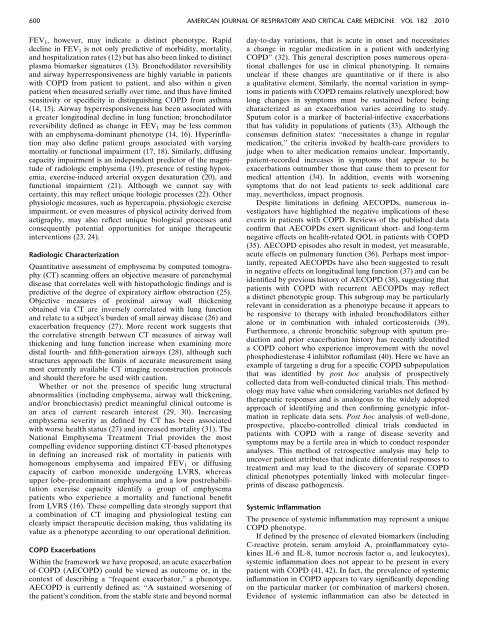


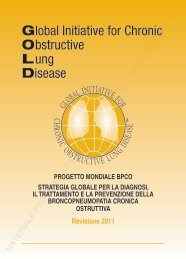
![Di Bari [NO].pdf - GOLD](https://img.yumpu.com/21544924/1/190x143/di-bari-nopdf-gold.jpg?quality=85)


